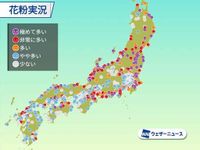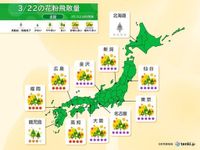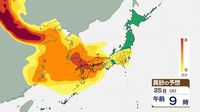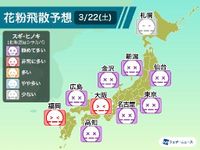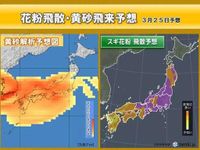Spring is bringing a double whammy of pollen and yellow sand to many regions in Japan, with a significant impact expected over the coming days. On March 23, 2025, pollen scattering will reach high levels from Kyushu to Tohoku, while a wave of yellow sand is set to sweep in around March 25, heightening concerns for those affected by allergies.
Residents are warned to brace for heavy pollen distribution particularly on March 23, when reports suggest that excessive levels of Japanese cedar pollen will be prevalent. These pollen counts are anticipated to fall into the "extremely high" category, especially in the Kinki, Kanto, and Hokuriku regions, where cedar pollen will continue to flourish as warmer temperatures push people outdoors.
According to forecasts, the pollen will likely peak around midday due to the mechanics of how it rises into the atmosphere. Flowering trees such as cedar release their pollen in the morning, and it is carried by winds across urban areas, often propping up airborne concentrations as the sun reaches its zenith.
Adding to this challenge is the phenomenon known as yellow sand, which is expected to impact western to eastern Japan starting March 23. This yellow sand originates from China's Taklamakan Desert and Gobi Desert, swept in by strong upper-level winds. Residents in the affected areas should be particularly cautious as dense droplets of yellow sand are anticipated to arrive on March 25, raising concerns about air quality and health.
Pollen and yellow sand can significantly affect individuals with respiratory issues or allergies. Various recommendations have been disseminated for those wishing to minimize exposure during this period. For instance, people are advised to avoid outdoor activities, especially on days with high yellow sand concentrations, and to stay indoors as much as possible.
"We expect that around 40% of people will report feeling very distressed due to the high pollen levels," said a spokesperson from Weathernews. This forecast aligns with reports indicating that as many as 253 hours of browsing on manga and novel sites occurred during work hours by a local official, illustrating the extent to which the pollen season is affecting health and productivity.
As temperatures soar over 20 degrees Celsius in many areas, particularly from Kanto to western Japan, this rise in temperature can exacerbate the pollen problem, making it crucial for those prone to hay fever to take extra precautions. Shifts in wind patterns around March 23 are likely to facilitate further pollen scattering, compounding the issue.
The presence of hinoki (cypress) pollen is also expected to escalate as March progresses, peaking from late March to early April. This introduces additional risks for individuals who are sensitive to this specific type of pollen, making vigilant measures necessary up to mid-April.
Experts strongly recommend several preventative measures to safeguard against pollen and yellow sand. Upon returning home, individuals should take special care to brush off any pollen lodged in clothing or hair, a practice suggested even for those who usually do not suffer from allergies. Additionally, keeping windows slightly ajar (around 10 cm) with lace curtains can reduce pollen entry while still allowing for ventilation.
Another key recommendation is to dry laundry indoors whenever possible, as this not only helps with pollen accumulation but also aids in guarding against yellow sand. Using air purifiers can significantly enhance air quality indoors, creating a more comfortable living environment.
This pollen season is compounded by reports from pending legislation that finds people turning to unproductive activities during work hours. The 60-year-old inspection officer gave insight into the emotional struggle many face due to the overwhelming pollen, stating, "I was trying to alleviate my frustration while working by browsing online. It's been tough during these peaks of pollen activity." His actions raised eyebrows, reflecting the lengths to which people go while struggling against nature's challenges.
Additionally, the impact of yellow sand on cars and laundry might lead to indirect economic consequences as people might avoid outdoor activities or result in an uptick in indoor cleaning measures. Authorities urge having clear windows washed gently with a high-pressure spray to avoid scratches while cleaning off the yellow dust.
As Japan experiences this double punch of seasonal pollutants, mindfulness and proactive management can help mitigate the adverse effects of pollen and yellow sand on health. Communities are called to remain informed and sensitive to the ongoing environmental changes.
By being vigilant in implementing preventive strategies, individuals can try to manage their health better while navigating this challenging pollen season. As cottonwoods bloom and local flora flourish, taking steps now can ensure a more comfortable and healthier spring for all.
